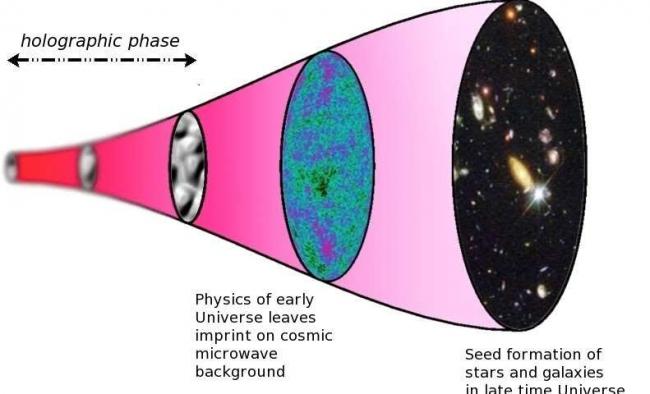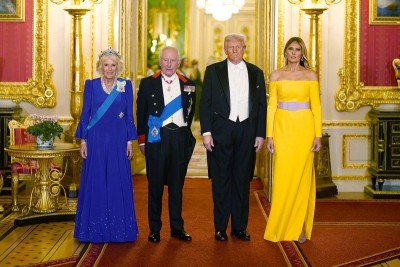
Canada: New study indicates concept of our life in a holographic universe
Their findings have been published in the Journal Physical Review Letters.
ScienceDaily quoted Professor Kostas Skenderis of Mathematical Sciences at the University of Southampton as saying: "Imagine that everything you see, feel and hear in three dimensions (and your perception of time) in fact emanates from a flat two-dimensional field. The idea is similar to that of ordinary holograms where a three-dimensional image is encoded in a two-dimensional surface, such as in the hologram on a credit card. However, this time, the entire universe is encoded!"
'It's a new paradigm for a physical reality,' said Skenderis, according to CBCNews.
The idea of a holographic universe was first proposed in the 1990s by scientists Leonard Susskind and Gerard 't Hooft in response to Stephen Hawking's black hole research.
The new research looks back almost 14 billion years to a time when the universe was in its early stage.
The scientists who worked on this for the past 20 years did not have the right tools or the right language to describe what was going on, said Skenderis
Data was collected by the Planck space telescope but unfortunately the telescope ceased operation in 2013.
But the telescope was able to map cosmic microwave background (CMB) radiation.
This data was studied by the researchers and they inferred that the radiation presented itself as heat extending outward in every direction, and lacked uniformity.
Researchers tried to map the findings as accurately as they could.
Researchers next used the holographic theory and mathematical formulas to calculate the predictions.
Lead author of the paper, Niayesh Afshordi of the Perimeter Institute and the University of Waterloo, told CBC News: "We live in three dimensions, I can [illustrate] it very easily: I can jump up and down, I can go back and forth, I can go left and right."
Theses findings helped researchers to bring the theories of quantum mechanics (the study of the very small) and general relativity (the study of the large) closer together, previously these were in conflict over how the universe worked.
Astrophysicists continued to search for the unified theory that would bring the two theories together.
Then a ground-breaking study released in the journal Physical Review Letters (arXiv.org version) offered the first observational evidence that the Universe could be a complex hologram. The study, led by University of Waterloo Professor Niayesh Afshordi, was believed to lead to new concepts on the Big Bang theory and quantum gravity.
Prof. Afshordi and his colleagues from UK, Canada and Italy at last were convinced that they had found substantial proof supporting a holographic explanation of the Universe.
“We are proposing using this holographic Universe, which is a very different model of the Big Bang than the popularly accepted one that relies on gravity and inflation,” Prof. Afshordi said.
“Each of these models makes distinct predictions that we can test as we refine our data and reports from Physical Review Letters said improve our theoretical understanding — all within the next five years.”
“We see the pictures as having height, width and crucially, depth – when in fact it all originates from a flat 2D screen. The difference, in our 3D Universe, is that we can touch objects and the ‘projection’ is ‘real’ from our perspective,” the researchers said.
Using this information, Prof. Afshordi, Prof. Skenderis and co-authors were able find that some of the simplest quantum field theories could explain nearly all cosmological observations of the early Universe.
“The key to understanding quantum gravity is understanding field theory in one lower dimension. Holography is like a Rosetta Stone, translating between known theories of quantum fields without gravity and the uncharted territory of quantum gravity itself,” Prof. Afshordi said.
“Scientists have been working for decades to combine Einstein’s theory of gravity and quantum theory. Some believe the concept of a holographic Universe has the potential to reconcile the two. I hope our research takes us another step towards this,” reports from Physical Review Letters said.
The authors hoped their work will lead to their further understanding of the early Universe and explain the emergence of space and time.
(Reporting by Asha Bajaj)
Image: phys.org Twitter
Support Our Journalism
We cannot do without you.. your contribution supports unbiased journalism
IBNS is not driven by any ism- not wokeism, not racism, not skewed secularism, not hyper right-wing or left liberal ideals, nor by any hardline religious beliefs or hyper nationalism. We want to serve you good old objective news, as they are. We do not judge or preach. We let people decide for themselves. We only try to present factual and well-sourced news.







